Experimental Study on the Performance of a Household Dual-Source Heat Pump Water Heater
Abstract
:1. Introduction
2. Experimental Setup
2.1. System Design
2.2. System Construction
2.3. Experimental Cases
3. Results and Discussion
3.1. Performance Indicators
3.2. Influence of the Preheater on the System
3.3. Influence of Bath Water and Air Temperatures on the System
3.4. Influence of the Bath Water Flow and Air Temperature on the System
3.5. Influence of an Air Source Evaporator on the System
3.6. Summary of Results
3.7. Comparison Between Experimental and Simulated Results
3.8. Economic Analysis
4. Conclusions
- (1)
- The average COP of the system reaches 4.79 without a preheater and air source evaporator. With an air source evaporator but without the preheater, the average COP of the system is 4.38, 8.6% lower; with a preheater but without an air source evaporator, the average COP of the system is 4.46, a reduction of 6.9%.
- (2)
- With a bath water temperature range of 35–42 °C and a bath flow rate of 5 L/min, the average COPs of the system are 4.53, 4.61, and 4.70 at the air temperatures of 19.4 °C, 22.9 °C, and 26.5 °C, respectively.
- (3)
- At a bath water flow rate range of 4–6 L/min and a bath water temperature of 40 °C, the average COPs of the system are 4.90, 4.98, and 5.07 at air temperatures of 19.4 °C, 22.9 °C, and 26.5 °C, respectively.
- (4)
- At a bath water temperature of 40 °C, a flow rate of 6 L/min, and an air temperature of 26.5 °C, the COP of the system can reach 6.08.
- (5)
- Compared with a traditional water heater, the household dual-source heat pump water heater can achieve significant energy savings.
Author Contributions
Funding
Conflicts of Interest
References
- Tian, E.; He, Y.L.; Tao, W.Q. Research on a new type waste heat recovery gravity heat pipe exchanger. Appl. Energy 2017, 188, 586–594. [Google Scholar] [CrossRef]
- Nam, Y.; Ooka, R.; Shiba, Y. Development of dual-source hybrid heat pump system using groundwater and air. Energy Build. 2010, 42, 909–916. [Google Scholar] [CrossRef]
- Jouhara, H.; Almahmoud, S.; Chauhan, A.; Delpech, B.; Bianchi, G.; Tassou, S.A.; Llera, R.; Lago, F.; Arribas, J.J. Experimental and theoretical investigation of a flat heat pipe heat exchanger for waste heat recovery in the steel industry. Energy 2017, 141, 1928–1939. [Google Scholar] [CrossRef]
- Hepbasli, A.; Kalinci, Y. A review of heat pump water heating systems. Energy Rev. 2009, 13, 1211–1229. [Google Scholar] [CrossRef]
- Liu, Z.; Xu, W.; Zhai, X. Feasibility and performance study of the hybrid ground-source heat pump system for one office building in Chinese heating dominated areas. Renew. Energy 2017, 101, 1131–1140. [Google Scholar] [CrossRef]
- Ikeda, S.; Choi, W.; Ooka, R. Optimization method for multiple heat source operation including ground source heat pump considering dynamic variation in ground temperature. Appl. Energy 2017, 193, 466–478. [Google Scholar] [CrossRef]
- Zhang, D.; Li, J.; Nan, J.; Wang, L. Thermal performance prediction and analysis on the economized vapor injection air-source heat pump in cold climate region of China. Sustain. Energy Technol. Assess. 2016, 18, 127–133. [Google Scholar] [CrossRef]
- Cai, J.; Ji, J.; Wang, Y.; Huang, W. Operation characteristics of a novel dual source multi-functional heat pump system under various working modes. Appl. Energy 2017, 194, 236–246. [Google Scholar]
- Wang, Z.H.; Wang, F.H.; Wang, X. Dynamic character investigation and optimization of a novel air-source heat pump system. Appl. Therm. Eng. 2017, 111, 122–133. [Google Scholar] [CrossRef]
- Gużda, A.; Szmolke, N. The efficiency of the heat pump water heater, during DHW tapping cycle. In Proceedings of the E3S Web of Conferences, Polanica-Zdrój, Poland, 13–15 September 2017. [Google Scholar]
- Song, M.; Xu, X.; Mao, N.; Deng, S.; Xu, Y. Energy transfer procession in an air source heat pump unit during defrosting. Appl. Energy 2017, 204, 679–689. [Google Scholar] [CrossRef]
- Safa, A.A.; Fung, A.S.; Kumar, R. Performance of two-stage variable capacity air source heat pump: Field performance results and TRNSYS simulation. Energy Build. 2015, 94, 80–90. [Google Scholar] [CrossRef]
- Su, H.; Gong, G.; Zhang, Y. Inversion Method for Optimizing the Condensing Heat Recovery System of an Air-Source Heat Pump. J. Energy Eng. 2017, 143, 04016069. [Google Scholar] [CrossRef]
- Shen, J.; Guo, T.; Tian, Y.; Xing, Z. Design and experimental study of an air source heat pump for drying with dual modes of single stage and cascade cycle. Appl. Therm. Eng. 2018, 129, 280–289. [Google Scholar] [CrossRef]
- Getu, H.M.; Bansal, P.K. Thermodynamic analysis of an R744–R717 cascade refrigeration system. Int. J. Refrig. 2008, 31, 45–54. [Google Scholar] [CrossRef]
- Jradi, M.; Veje, C.; Jørgensen, B.N. Performance analysis of a soil-based thermal energy storage system using solar-driven air-source heat pump for Danish buildings sector. Appl. Therm. Eng. 2017, 114, 360–373. [Google Scholar] [CrossRef]
- Li, Y.; Li, W.Y.; Liu, Z.S.; Lu, J.; Zeng, L.Y.; Yang, L.L.; Xie, L. Theoretical and numerical study on performance of the air-source heat pump system in Tibet. Renew. Energy 2017, 114, 489–501. [Google Scholar] [CrossRef]
- Zhang, L.; Jiang, Y.; Dong, J.; Yao, Y.; Deng, S. An experimental study of frost distribution and growth on finned tube heat exchangers used in air source heat pump units. Appl. Therm. Eng. 2018, 132, 38–51. [Google Scholar] [CrossRef]
- Fernandez, N.; Hwang, Y.; Radermacher, R. Comparison of CO2 heat pump water heater performance with baseline cycle and two high COP cycles. Int. J. Refrig. 2010, 33, 635–644. [Google Scholar] [CrossRef]
- Zhao, Z.C.; Zhang, Y.R.; Mi, H.J.; Zhou, Y.M.; Zhang, Y. Experimental Research of a Water-Source Heat Pump Water Heater System. Energies 2018, 11, 1205. [Google Scholar] [CrossRef]
- Chao, S.; Jiang, Y.; Yang, Y. A field study of a wastewater source heat pump (WWSHP) for domestic hot water heating. Build. Serv. Eng. Res. Technol. 2013, 34, 433–448. [Google Scholar] [CrossRef]
- Liu, L.B.; Fu, L.; Jiang, Y. Application of an exhaust heat recovery system for domestic hot water. Energy 2010, 35, 1476–1481. [Google Scholar] [CrossRef]
- Schibuola, L.; Scarpa, M. Experimental analysis of the performances of a surface water source heat pump. Energy Build. 2016, 113, 182–188. [Google Scholar] [CrossRef]
- Liu, X.Y.; Lau, S.K.; Li, H.R.; Shen, H. Optimization and analysis of a multi-functional heat pump system with air source and gray water source in cooling mode. Energy Build. 2014, 69, 1–13. [Google Scholar] [CrossRef]
- Liu, X.F.; Liu, C.H.; Zhang, Z.; Chen, L.; Hou, Y. Experimental Study on the Performance of Water Source Trans-Critical CO2 Heat Pump Water Heater. Energies 2017, 10, 810. [Google Scholar] [CrossRef]
- Wanjiru, E.M.; Sichilalu, S.M.; Xia, X.H. Optimal control of heat pump water heater-instantaneous shower using integrated renewable-grid energy systems. Appl. Energy 2017, 201, 332–342. [Google Scholar] [CrossRef]
- Dong, Y.Q. Theory of energy level and its application in water-loop heat pump system. Appl. Therm. Eng. 2017, 119, 269–274. [Google Scholar]
- Lazzarin, R.M. Dual source heat pump systems: Operation and performance. Energy Build. 2012, 52, 77–85. [Google Scholar] [CrossRef]
- Cai, J.Y.; Ji, J.; Wang, Y.Y.; Zhou, F.; Yu, B. A novel PV/T-air dual source heat pump water heater system: Dynamic simulation and performance characterization. Energy Convers. Manag. 2017, 148, 635–645. [Google Scholar] [CrossRef]
- Wong, L.T.; Mui, K.W.; Guan, Y. Shower water heat recovery in high-rise residential buildings of Hong Kong. Appl. Energy 2010, 87, 703–709. [Google Scholar] [CrossRef]
- Gou, X.; Fu, Y.; Shah, I.A.; Li, Y.M.; Xu, G.Y.; Yang, Y.; Wang, E.Y.; Liu, L.S.; Wu, J.X. Research on a Household Dual Heat Source Heat Pump Water Heater with Preheater Based on ASPEN PLUS. Energies 2016, 9, 1026. [Google Scholar] [CrossRef]
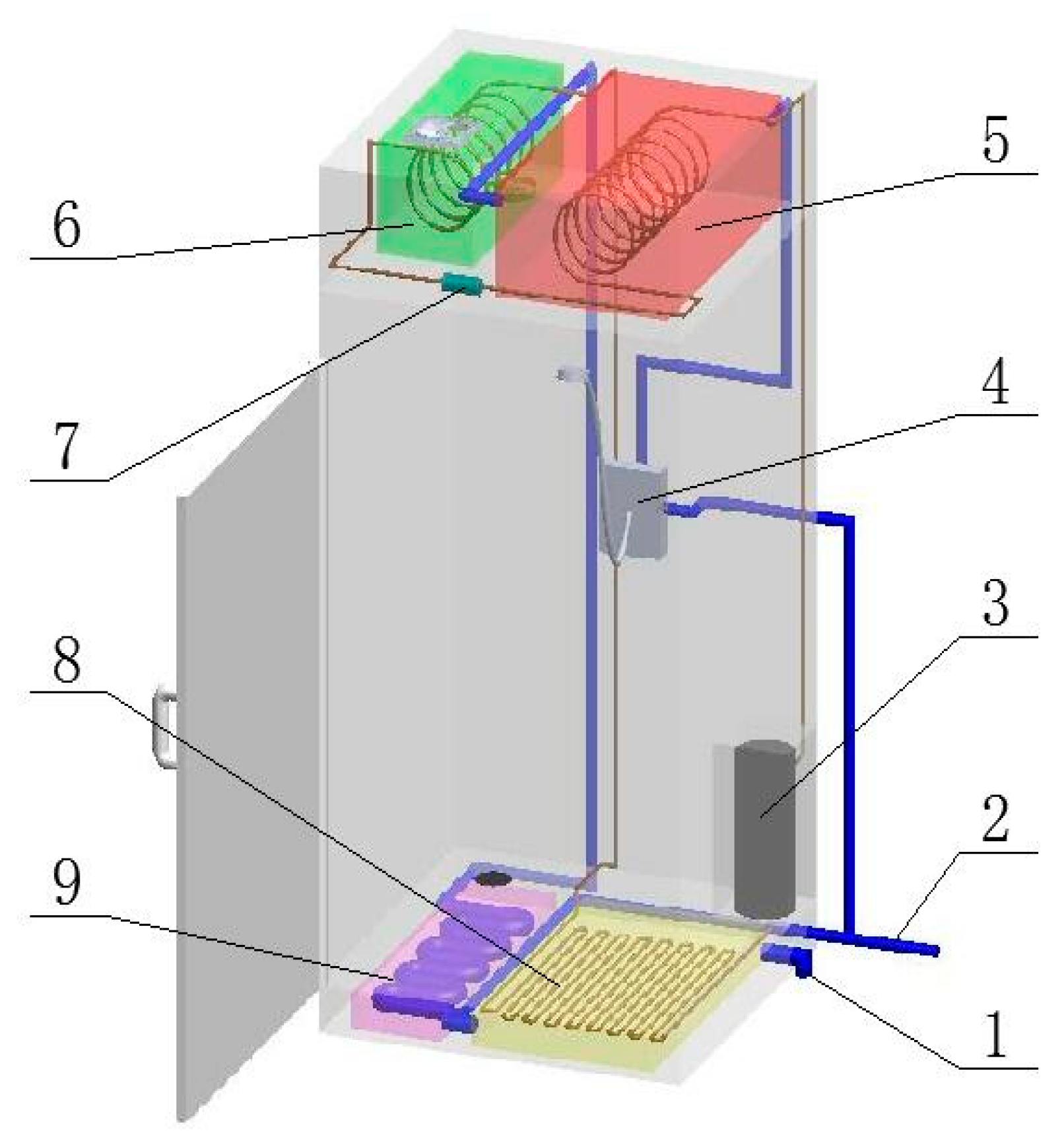

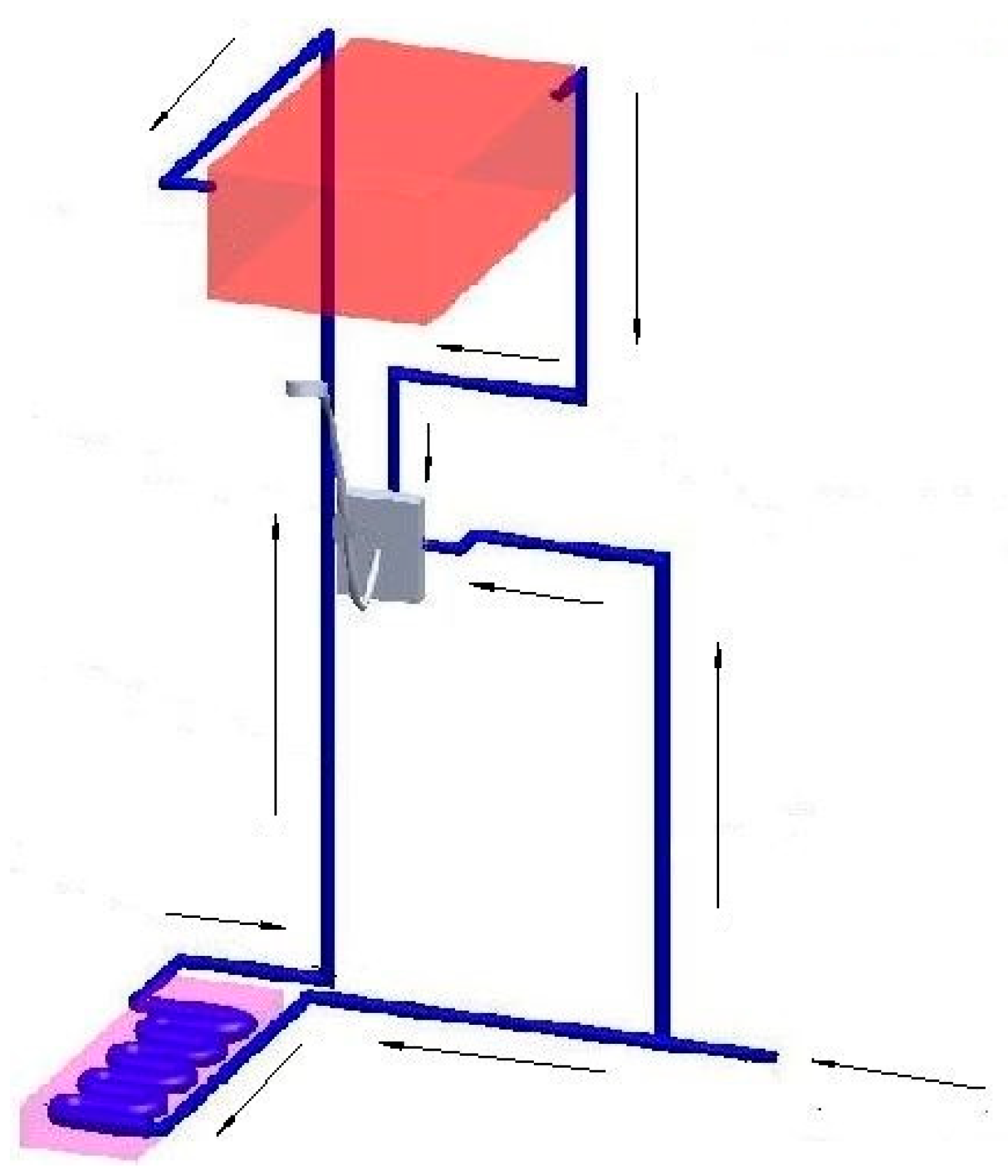





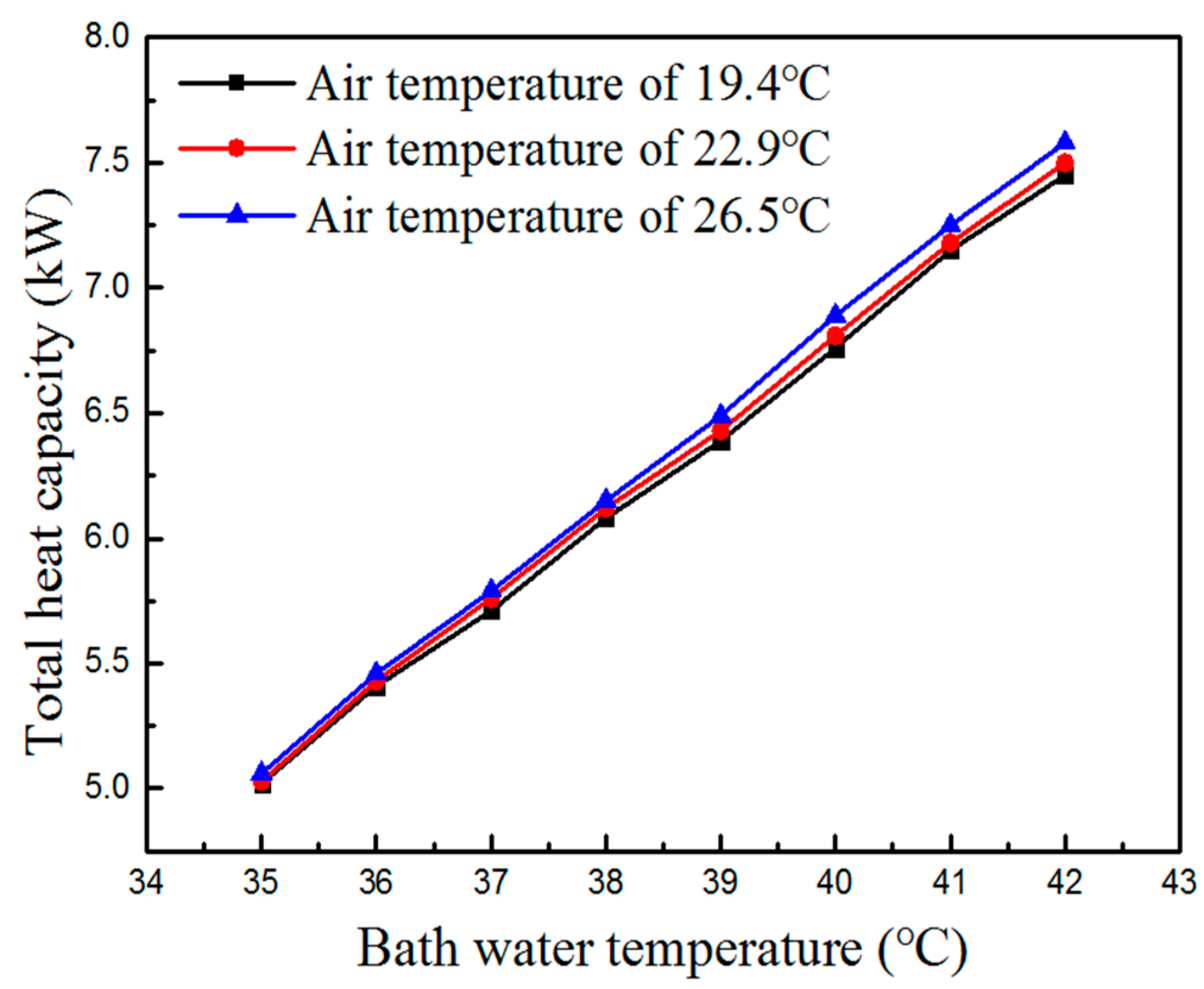

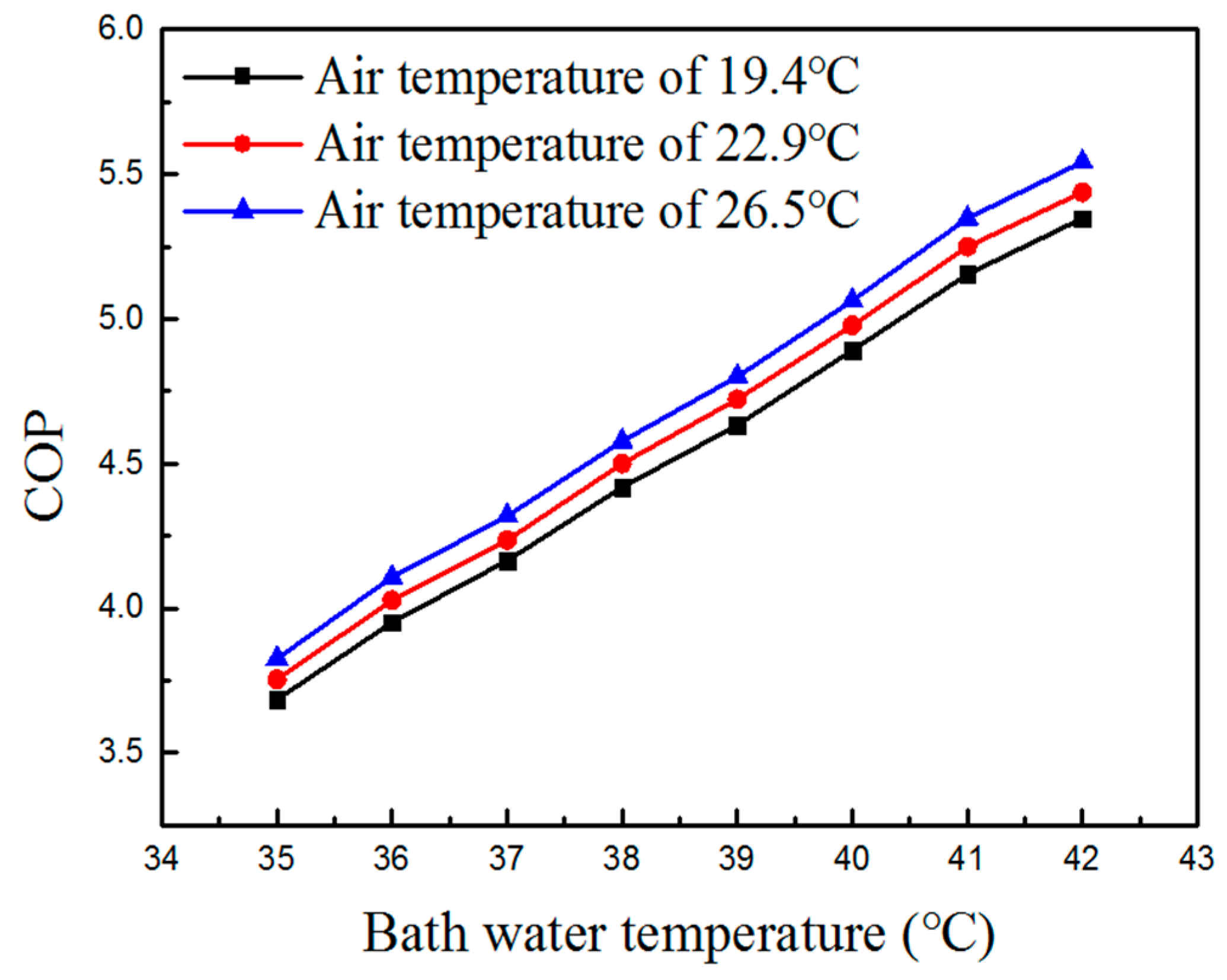
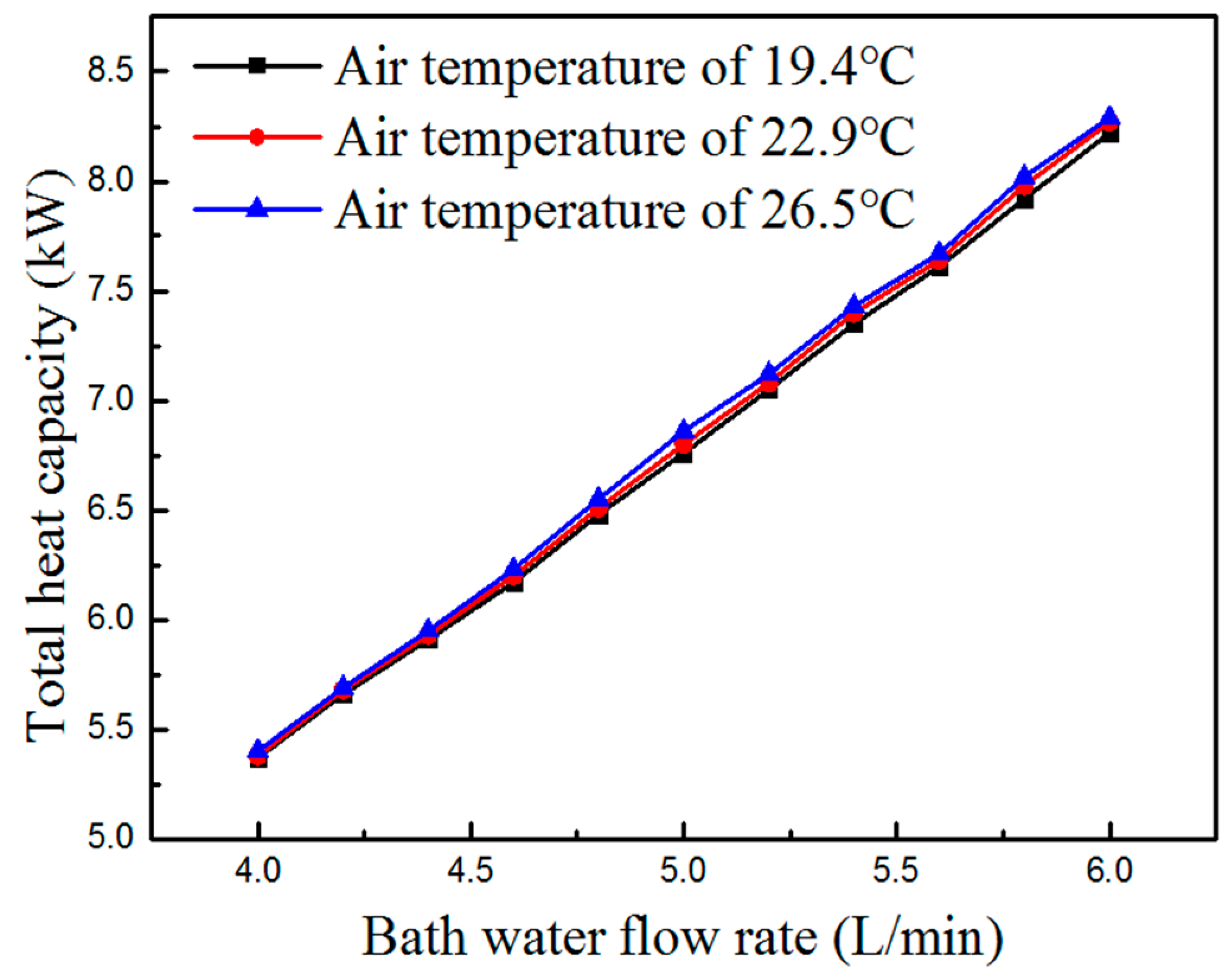
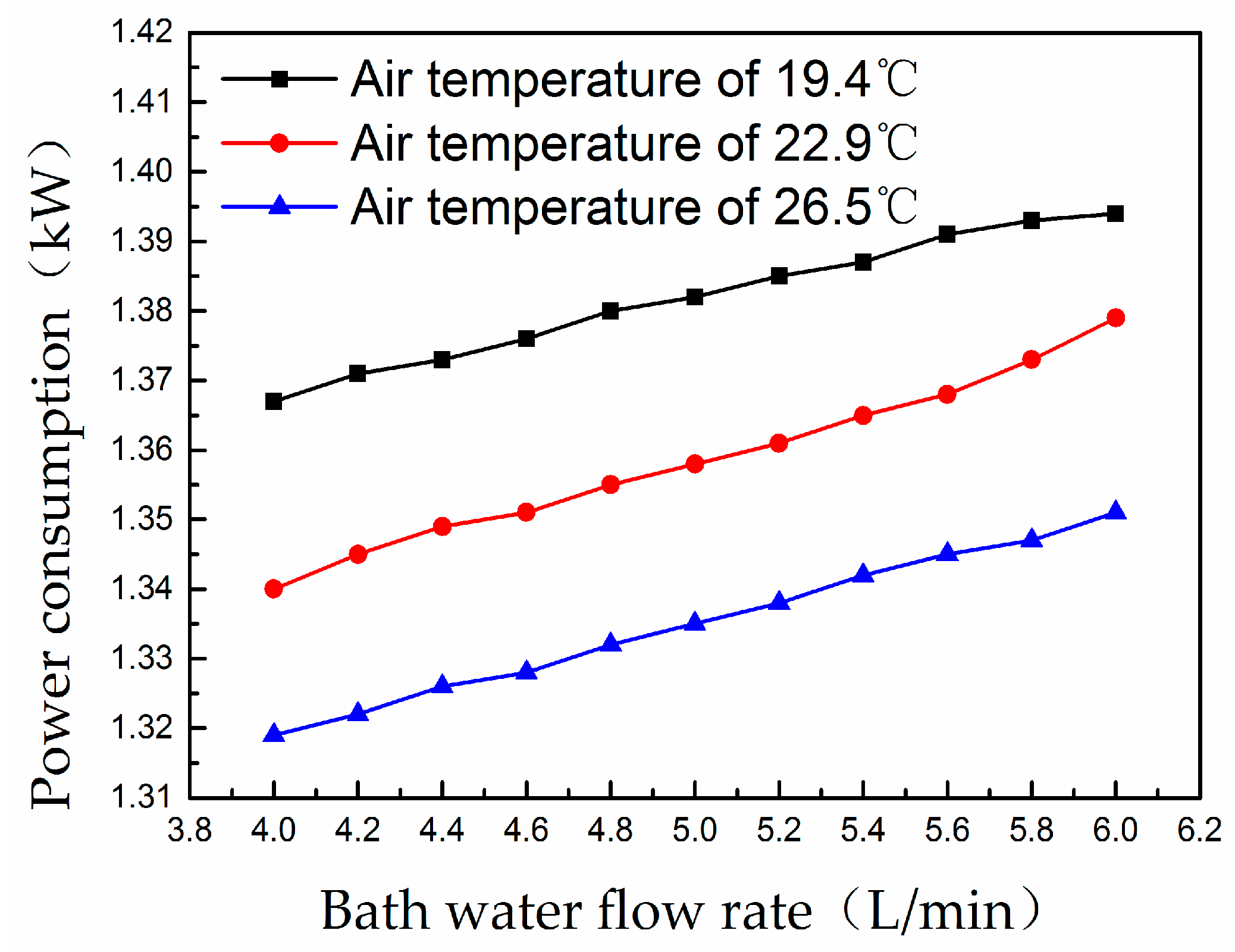


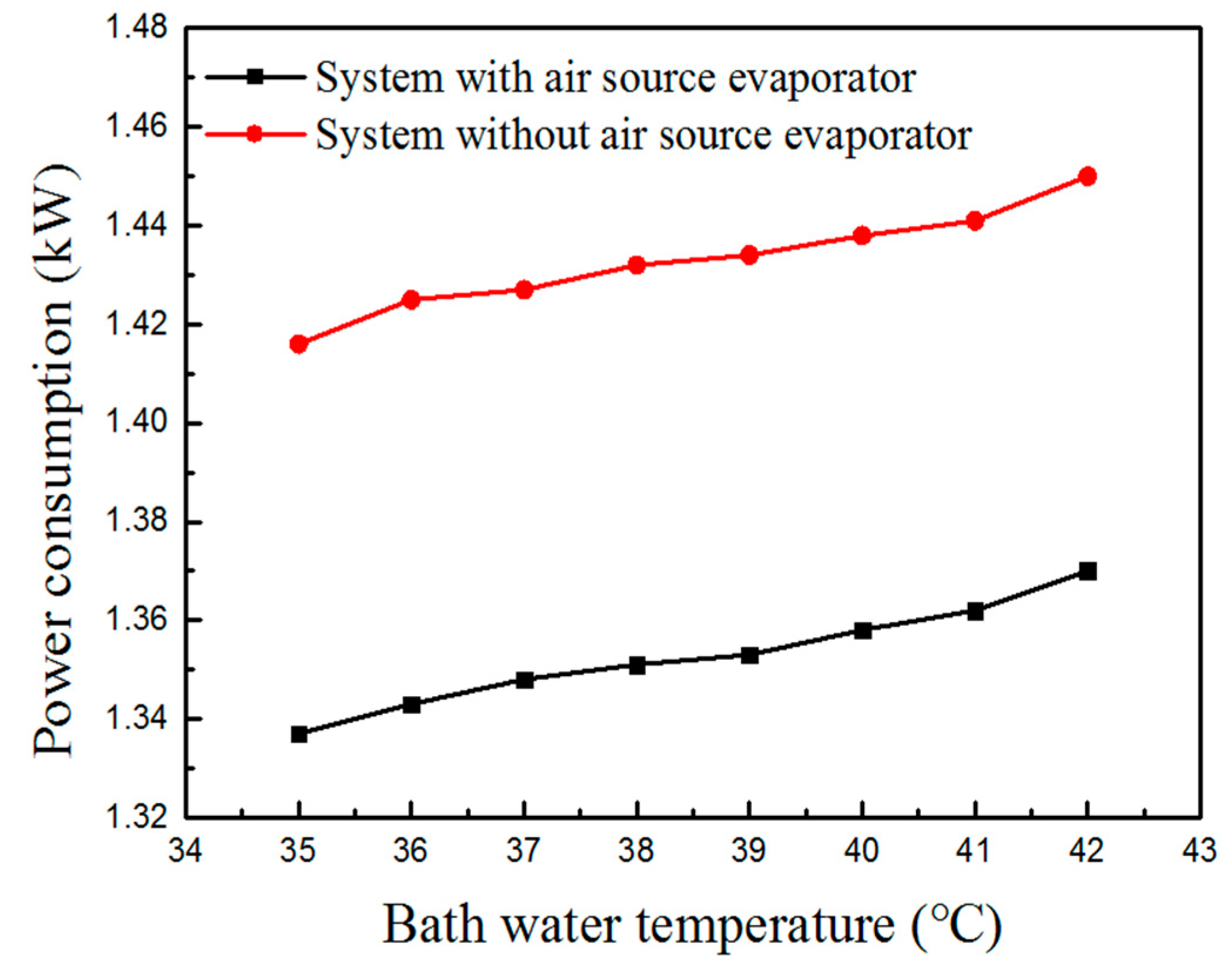
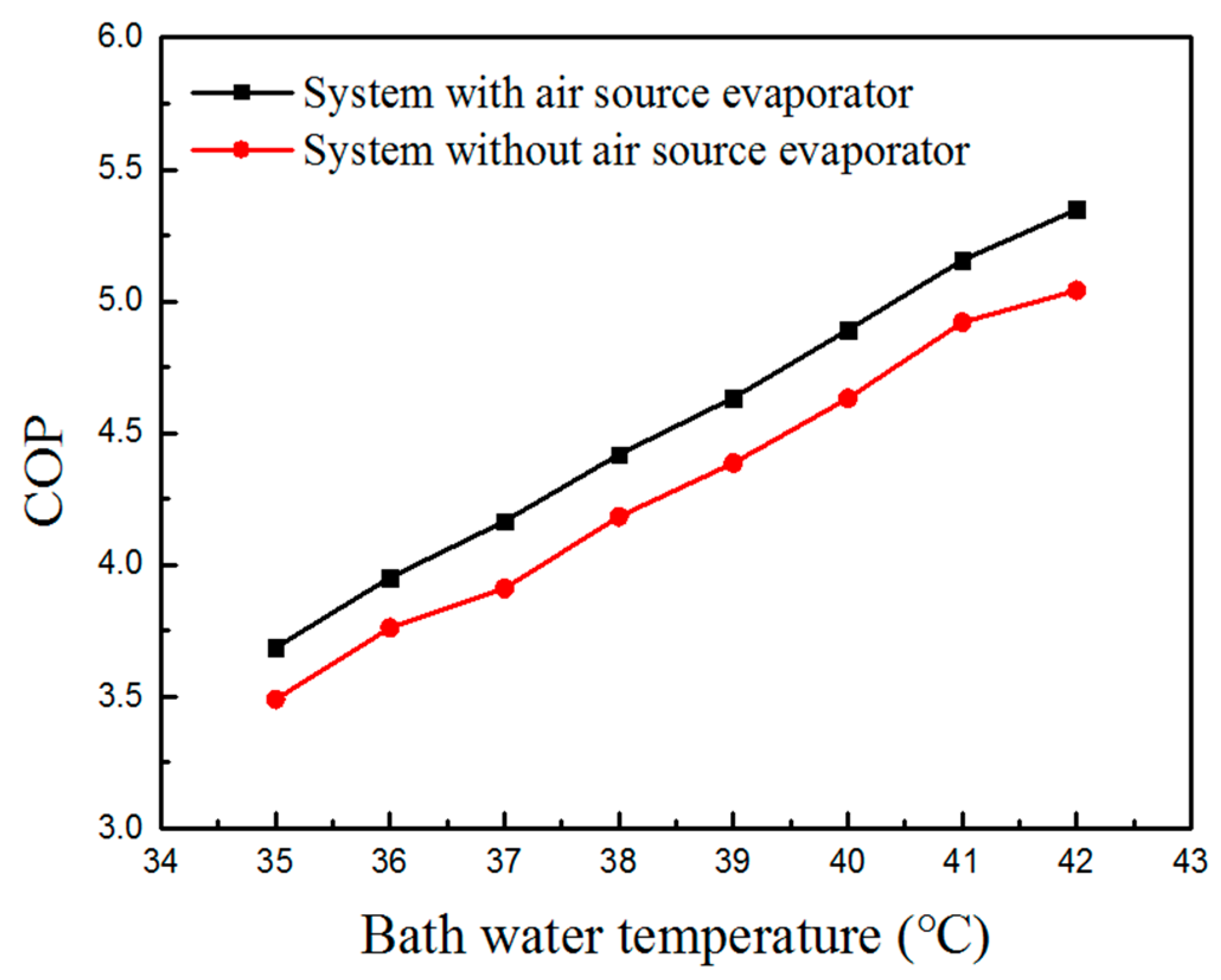

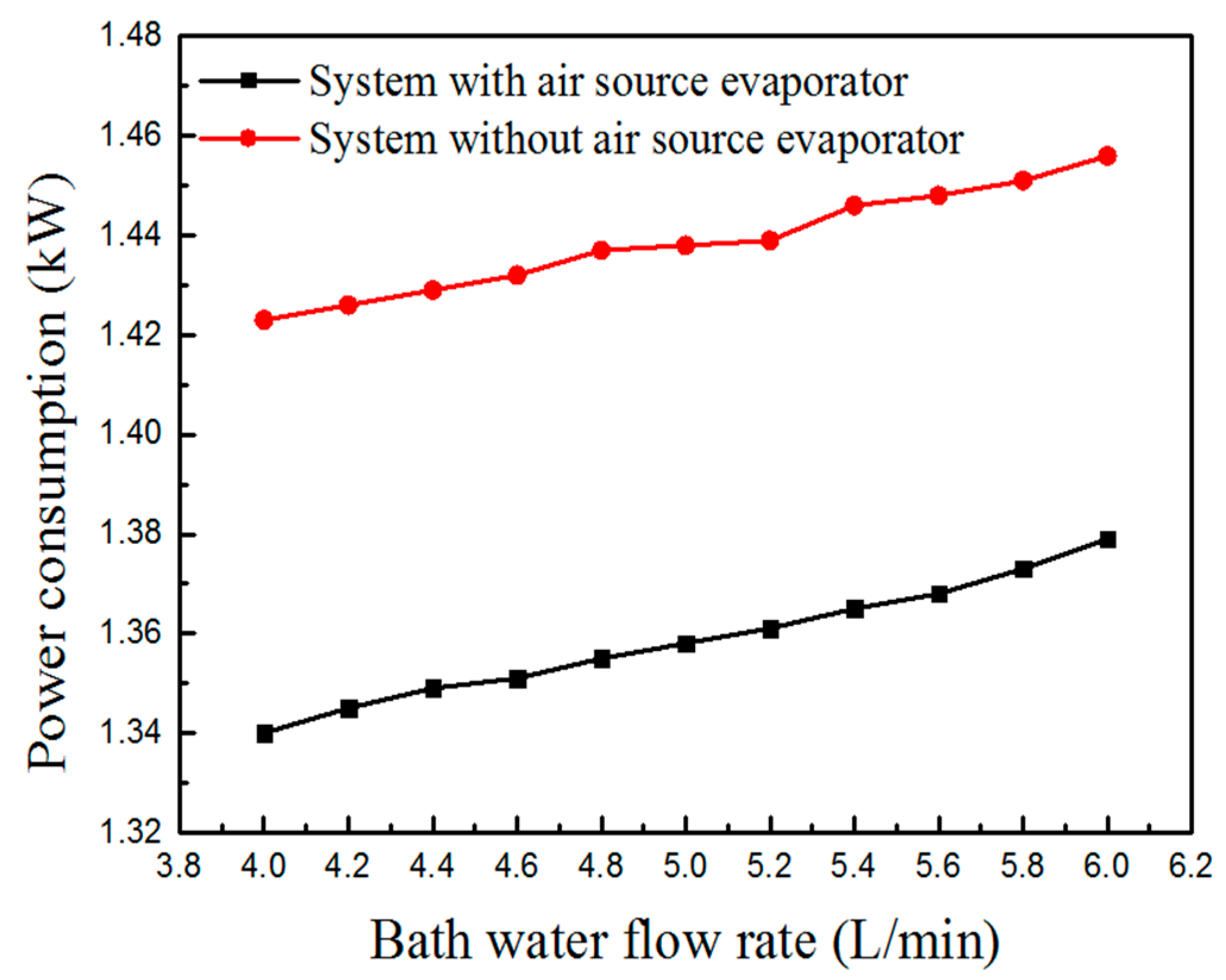




| Case Number | Bath Water Temperature (°C) | Bath Water Flow Rate (L/min) | Air Temperature (°C) | Preheater | Air Source Evaporator |
|---|---|---|---|---|---|
| 1 | 35–42 | 5 | 22.9 | on/off | on |
| 2 | 40 | 4–6 | 22.9 | on/off | on |
| 3 | 35–42 | 5 | 19.4, 22.9, 26.5 | on | on |
| 4 | 40 | 4–6 | 19.4, 22.9, 26.5 | on | on |
| 5 | 35–42 | 5 | 22.9 | on | on/off |
| 6 | 40 | 4–6 | 22.9 | on | on/off |
| Case Number | Conditions | Average Power Consumption (Range) (kW) | Average COP of System (Range) | |
|---|---|---|---|---|
| 1 | Bath water temperature 35–42 °C | Preheater on | 1.35 (1.34–1.37) | 4.61 (3.75–5.44) |
| Preheater off | 1.49 (1.47–1.50) | 4.21 (3.41–4.98) | ||
| 2 | Bath water flow rate 4–6 L/min | Preheater on | 1.35(1.34–1.38) | 4.99 (4.01–6.02) |
| Preheater off | 1.49 (1.47–1.50) | 4.54 (3.58–5.50) | ||
| 3 | Bath water temperature 35–42 °C | Air temperature of 19.4 °C | 1.38 (1.36–1.39) | 4.53 (3.69–5.35) |
| Air temperature of 22.9 °C | 1.35 (1.34–1.37) | 4.61 (3.75–5.44) | ||
| Air temperature of 26.5 °C | 1.33 (1.31–1.34) | 4.70 (3.82–5.54) | ||
| 4 | Bath water flow rate 4–6 L/min | Air temperature of 19.4 °C | 1.38 (1.37–1.39) | 4.90 (3.82–5.72) |
| Air temperature of 22.9 °C | 1.35 (1.34–1.38) | 4.98 (4.01–5.96) | ||
| Air temperature of 26.5 °C | 1.33 (1.32–1.35) | 5.07 (4.07–6.08) | ||
| 5 | Bath water temperature 35–42 °C | Air source evaporator on | 1.35 (1.34–1.37) | 4.53 (3.68–5.35) |
| Air source evaporator off | 1.43 (1.42–1.45) | 4.29 (3.48–5.00) | ||
| 6 | Bath water flow rate 4–6 L/min | Air source evaporator on | 1.35 (1.34–1.38) | 4.98 (4.01–5.96) |
| Air source evaporator off | 1.44 (1.42–1.46) | 4.63 (3.71–5.58) | ||
© 2018 by the authors. Licensee MDPI, Basel, Switzerland. This article is an open access article distributed under the terms and conditions of the Creative Commons Attribution (CC BY) license (http://creativecommons.org/licenses/by/4.0/).
Share and Cite
Gou, X.; Liu, S.; Fu, Y.; Zhang, Q.; Iram, S.; Liu, Y. Experimental Study on the Performance of a Household Dual-Source Heat Pump Water Heater. Energies 2018, 11, 2811. https://doi.org/10.3390/en11102811
Gou X, Liu S, Fu Y, Zhang Q, Iram S, Liu Y. Experimental Study on the Performance of a Household Dual-Source Heat Pump Water Heater. Energies. 2018; 11(10):2811. https://doi.org/10.3390/en11102811
Chicago/Turabian StyleGou, Xiang, Shian Liu, Yang Fu, Qiyan Zhang, Saima Iram, and Yingfan Liu. 2018. "Experimental Study on the Performance of a Household Dual-Source Heat Pump Water Heater" Energies 11, no. 10: 2811. https://doi.org/10.3390/en11102811





